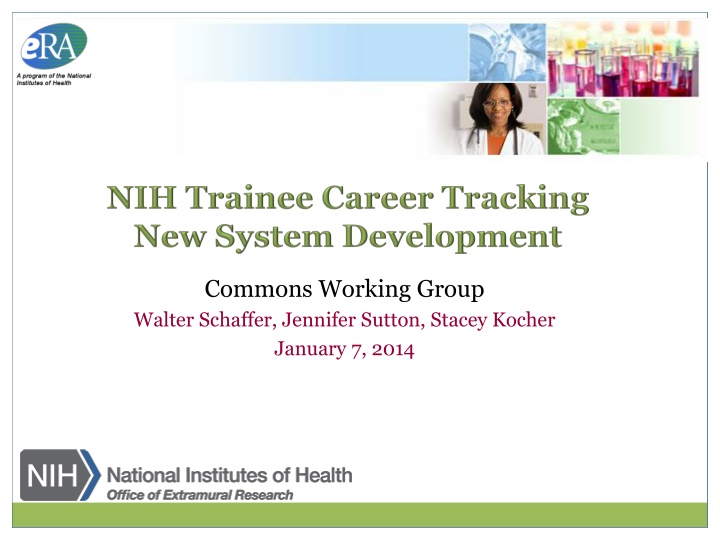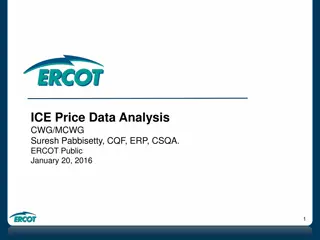
Biomedical Workforce Training Initiatives Overview
The document presents an overview of initiatives and challenges in biomedical and behavioral training, including reshaping programs to suit diverse career outcomes, addressing equity issues, leveraging existing data collections, and improving access to training and career information. It also outlines NIH initiatives resulting from the Biomedical Workforce Task Force, such as establishing grant programs for innovative training approaches and developing a comprehensive tracking system for trainees. The discussion extends to seeking input on data submission processes for institutional training grants and integration with eRA systems.
Download Presentation

Please find below an Image/Link to download the presentation.
The content on the website is provided AS IS for your information and personal use only. It may not be sold, licensed, or shared on other websites without obtaining consent from the author. If you encounter any issues during the download, it is possible that the publisher has removed the file from their server.
You are allowed to download the files provided on this website for personal or commercial use, subject to the condition that they are used lawfully. All files are the property of their respective owners.
The content on the website is provided AS IS for your information and personal use only. It may not be sold, licensed, or shared on other websites without obtaining consent from the author.
E N D
Presentation Transcript
Commons Working Group Walter Schaffer, Jennifer Sutton, Stacey Kocher January 7, 2014
2 Background (Wally) Goals (Wally) Challenges (Jennifer) Changes to Date (Jennifer) New System (Stacey) Project Status and Timeline (Stacey) How to Get Involved (Stacey and/or Megan)
3 Increased interest in many aspects of biomedical and behavioral training Yield and Cost Recent analysis indicates that biomedical PhDs enter a wide variety of research and research-related careers Only about a quarter of all PhDs hold tenure-track faculty positions in academic settings Suggests that programs need to be reshaped and the skill sets broadened to accommodate existing career outcomes Equity Some demographic groups are underrepresented Suggest untapped skills and creativity Craft Institutions and Training Program Directors already collect huge amounts of data used primarily in the review process not available for analysis Leverage existing collections, re-use existing data to help reduce burden Improve access to information on training experiences and career outcomes
4 Report of the Biomedical Workforce Task Force* led to a series of NIH initiatives, including #3 Establish a grant program to encourage innovative training approaches 1) 2) Improve graduate student and postdoctoral researcher training 3) Develop a simple and comprehensive tracking system for trainees 4) Encourage fair consideration of staff scientists on grant applications 5) Initiate discussion with the community to assess NIH support of faculty 6) Create an office in the NIH Office of the Director to assess the biomedical research workforce 7) Conduct ACD Working Group study on optimal research training of individuals in clinical disciplines *http://acd.od.nih.gov/bwf.htm
5 This is where you come in! NIH requires submission of data for institutional training grants at the time of application and progress reporting. We d like to have a conversation with you about the current process: How your institution deals with collecting and submitting the data issues, concerns? What might be the best approach for integrating it with current eRA systems? Solicit your help and review of our approach as we move along 1. 2. 3.
6 Develop a simple and comprehensive tracking system for trainees Identify all NIH supported students and post-docs Automate training tables required for institutional training grants Develop a fed-wide researcher profile system in collaboration with FDP (SciENcv) (Lori Schultz & Ron Splittgerber serve as FDP contacts) Encourage adoption of unique, persistent researcher IDs (ORCID)
7 Develop a simple and comprehensive tracking system for trainees Reduce data entry wherever possible Capitalize on existing data collection (Commons Person Profile, xTRAIN, etc.) Integrate with SciENcv (helps with all of the above)
8 Privacy Second party data entry of sensitive Personally Identifiable Information (PII) Current training table structure results in small cell sizes Balancing need for information with burden of reporting Incomplete profile data and/or outdated data, particularly for historical trainees Coordination with other sources of data including academic institutions who have existing systems
9 July 2013: New eRA Commons Person Profile Screens Easier to navigate and identify missing information thanks for your support! Enhanced collection of demographic data August 2013: New role options added to eRA Commons to allow for routine reporting on undergraduate and graduate students Guide Notice: http://grants.nih.gov/grants/guide/notice-files/NOT- OD-13-097.html
10 October 2013: Began pilot testing of the new SciENcv for creating biosketches for NIH applications; will include data sharing with eRA Commons November 2013: In preparation for required reporting on students working on NIH grants in 2014, added a warning when RPPR is submitted without a Commons ID for those with a student role or if the student hasn t completed a Commons Personal Profile. December 2013: Formed NIH training policy subcommittee to review current table reporting requirements and instructions
11 Trainee Reporting and Career Tracking = xTRACT NIH sponsored enterprise-wide system: Agency commitment to IT support, security, and reporting consistency Project scope: Develop a system to collect the data needed for training grant applications Current status: Preliminary requirements gathering eRA Wants YOU! Your feedback, insight and advice will be very helpful
12 Make it easy to access Include as a tab in the eRA Commons if users agree Utilize existing system functionality/concepts (i.e. roles, privileges, delegation) Similar look/feel to new Commons Person Profile Address the following concerns to make it simpler to provide data Currently PDF forms only; multiple data in one field; confusing instructions Discrete data provided is not stored and cannot be reused, queried or easily retrieved Requires duplicate entry & submission each year after grant award
13 Reduce data entry wherever possible When Commons ID or Grant # is available: Populate information from Commons Personal Profile, xTRAIN, MyNCBI (publications), etc. Provide ability to copy and update/edit prior year training table submissions Use the best of what current systems have implemented Two NIH institutes have internal systems Some institutions have developed automated methods to provide the reports
14 Getting the word out introducing the new system and soliciting support and assistance Business requirements gathering Established Core NIH Advisory Team Members include Program and Review staff from several ICs (NIEHS, NINDS, FIC, NIGMS, NCI, NIMH, NHLBI, NIAID, NICHD) as well as NIH Extramural policy staff Policy subcommittee formed to review reporting requirements and instructions Forming external institution group for requirements feedback & pilot
15 Requirements System Development - Testing Engage User Acceptance Testing Gather staff and policy requirements; clearances Institution Pilot NIH staff User Acceptance Testing: Production Iterative development with feedback loop Roll out beta pilot of the system. Implement Corrections/Feedback Go live date! Internal testing Oct 2013 Sept 2014 April 2014 September 2014 March 2015 Accelerated Timeline: System pilot in Sept 2014; rollout initial version in March 2015.
16 Institution initial data upload (one time load of trainee and faculty data) System to system reporting Other items discovered in User Acceptance Testing and pilot
17 We will be soliciting input and feedback on our requirements and progress as we move forward. If you would like to participate in discussions regarding your institution business processes for training grant reporting and the pilot (currently scheduled for Sept 2014) please contact: Stacey Kocher: kochers@mail.nih.gov Amanda Wingo: wingoaj@mail.nih.gov
18 For more information on the NIH s activities regarding the Biomedical Workforce initiatives: NIH Biomedical Research Workforce Website: http://biomedicalresearchworkforce.nih.gov/ Dr. Sally Rockey s Blog: http://nexus.od.nih.gov/all/2013/04/11/taking-on-the-challenge-of-better- biomedical-workforce-data/ SciENcv: http://www.nlm.nih.gov/pubs/techbull/so13/so13_sciencv.html Blank Data Tables, Instructions, & Samples of the current training tables: http://grants.nih.gov/grants/funding/424/index.htm#data





















